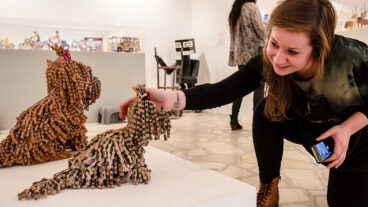What are the limits of protest against freedom of expression?The incident in which Israel’s ambassador in Sweden, Zvi Mazel, damaged an art installation that seemed to express sympathy for acts of suicide and murder at the Maxim restaurant in Haifa, raises questions about the limits of freedom of artistic expression, and the limits of protest against this same freedom of expression.
The installation itself should come as no surprise, as the Tel Aviv Museum has exhibited a work in which a swastika was incorporated into a Jewish star. It is not surprising that the museum in Stockholm or that an Israeli is involved in the galling installation. These sorts of installations have become a matter of routine in Western art galleries, museums and campuses.
Their designers – out of a reticence to use the word artists – defend them by citing two arguments: first, that art should not be disengaged from politics; second, that there is no justification for censorship or supervision of the freedom of artistic expression. Acquiescence to such censorship would strip away the barrier that prevents the slide down that slippery slope that leads to a fascist state in which the fate of creative artists would be determined by the interests of the state.
Both arguments seem persuasive: historical experience proves that all censorship is perverted and arbitrary, and leads to the suppression of important works – the censorship of the books of D.H. Lawrence and James Joyce immediately comes to mind.
However, further examination proves the untenability of this argument. First, no right guaranteed by law is unlimited. The Supreme Court has several times explained that freedom of expression, important and lofty as it may be, is not absolute, and in some cases may be set aside in favor of other considerations of the public good – public order, the individual’s dignity and good name, independence of the courts, state security and religious sensitivities.
It is therefore impossible to argue that freedom of expression may be restricted in all realms, and that freedom of expression becomes unlimited only when an artist translates his worldview into politics. Would those on the left who favor unlimited artistic freedom be willing to have it apply to installations created by Kahane supporters or members of the Ku Klux Klan?
The left claims – as it has in the matters of the refuseniks and of academic freedom – that there is a vast difference between expression with the purpose of repression of human beings and expression with the purpose of defending human rights. Yet this argument is by nature anti-universal and arbitrary. When a basic right is granted, you must be politically color-blind; otherwise, the right will lose its credibility.
The example of the installation in Stockholm drives this point home: the installation seems to express sympathy for the murder of civilians – adults and children, Jews and Arabs – in the must vulgar manner. Can such an installation be classified as a work that defends human rights, and is therefore immune to censorship, or as a dark and repressive work that cannot be defended? In fact, can’t this sort of murder be categorized, psychologically and ideologically, with the world of the Kach movement and of the most despicable racism?
There is another way in which this installation fails to represent human and universal values: Not only in Israel are Muslims committing suicide to murder civilians. Murder through suicide terrorism is now prevalent in Russia, Morocco, Saudi Arabia, Iraq, Indonesia and other countries. But the only installations about this subject, the only demonstrations held in the streets of Europe and protests at Berkeley and on other American college campuses – are directed against Israel.
A Greek gallery in Athens exhibited a work of art in the shape of an explosives belt made of macrame, of a Palestinian female terrorist wishing to kill Israelis. Only against Israel are these sorts of masterpieces exhibited – never against other countries, never out of an understanding for suicide bombers who murder civilians that are not Israelis. There is no macrame for Chechnyans. There is no installation in Sweden that understands the suicide bombers in Riyadh. If this is not racism, it is unclear what is.
(Originally appeared in Ha’aretz. Reprinted with permission of the author)












